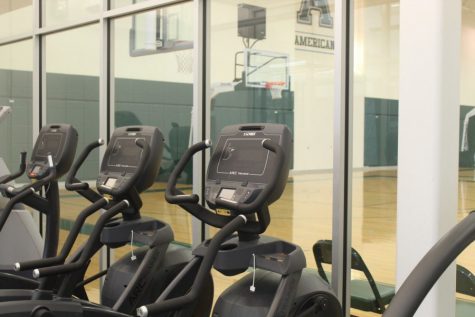Reaching new heights: Tulane athletics opens altitude training chamber in Hertz Center
April 17, 2019

The altitude chamber looks out on a practice basketball court in the Hertz Center.
Because the highest point in New Orleans is just 43 feet above sea level, the Crescent City’s athletes rarely encounter the challenges presented by training at a significant altitude. To offer an innovative solution to this problem, Tulane athletics recently unveiled an altitude training room, the first of its kind on a college campus in the U.S.
The chamber mimics the oxygen levels that would be experienced an altitude of approximately 10,000 feet. It is also temperature and humidity controlled, but these functions are held at a typical indoor level and coordinated through air conditioning in the model Tulane commissioned.
Though such technology is not cheap, Tulane’s chamber was funded by a large donation from Avron B. and Wendy Fogelman. The room itself is located in the Hertz Center, the Green Wave’s basketball and volleyball training facility.
In addition to offering acclimation to competition at higher altitudes, it has been theorized that training at higher altitudes generally improves an athlete’s stamina. Proponents of this method argue that altitude training increases the amount of red blood cells that an athlete’s body produces, which in turn increases the amount of oxygen delivered around the body.
According to Altitude International, the company that built Tulane’s altitude chamber, there is a large body of work to support these techniques. On a webpage that links to numerous studies, the company offers the following statement.
“Adaptations [from altitude training] allow for performance improvements which are unattainable with any other training method and propel elite athletes to best-ever achievements.”
Not all sources, however, agree about the benefits of altitude training for college athletes. In fact, one study has shown that 12-16 hours a day need to be spent at a simulated high altitude for any noticeable changes to be recorded, an amount that is likely not possible for college athletes.
Furthermore, of Tulane’s 11 basketball conference opponents, five – University of Central Florida, University of Houston, University of Memphis, University of Southern Florida and Temple University – are located in cities in which the highest point is below 500 feet.
Three others – Southern Methodist University, University of Cincinnati and University of Tulsa – are located in cities in which the highest point is below 1,000 feet.
Still, in tandem with new training techniques and the hiring of Ron Hunter, this chamber could offer a viable option to increase the status of the men’s basketball team. Fans will certainly be watching with bated breath to see if these investments pay off.








Leave a Comment